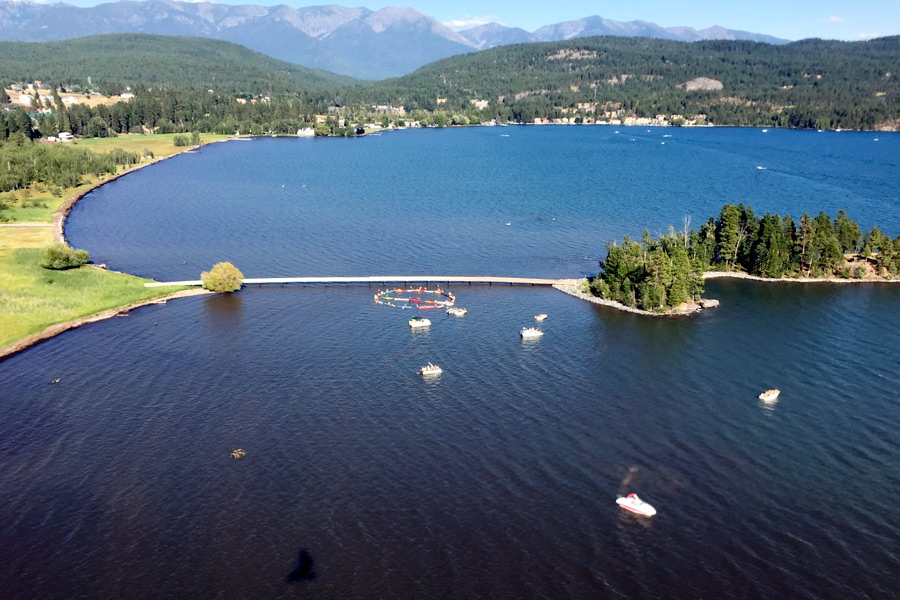Judge Orders Demolition Plan for Ill-fated Bridge on Flathead Lake’s North Shore
Calling it a ‘foolhardy boondoggle,’ Judge Robert Allison wrote that he is frustrated by the lack of progress in removing the ‘bridge to nowhere’
By Tristan Scott
Calling the decision to build a private “bridge to nowhere” spanning the north shore of Flathead Lake a “foolhardy boondoggle,” a district judge paid no sympathy to its architects this week when he ordered an expedited plan for the ill-fated and illegal structure’s removal and expressed frustration over repeated delays.
The Dec. 7 order by Flathead County District Judge Robert B. Allison comes more than a year after the Montana Supreme Court affirmed his decision that the vehicular bridge west of Bigfork was built without a valid permit and must be removed to restore the prized lakeshore to its original condition. The district court’s most recent judgment is in response to requests by landowner Jolene Dugan and her father, Roger Sortino, who sought to delay the 519-by-16-foot bridge’s demolition due to financial strain they say they’ve incurred due to the COVID-19 pandemic, stalling forward progress on the costly project.
In a stern rebuke, Allison denied the request for delay and ruled in favor of a motion by the Community Association for North Shore Conservation (CANSC), a group that successfully challenged the bridge’s legal standing and have asked for a court-ordered deadline to speed its removal, as per the judgment.
“The execution of the judgment has become as problematic as the effort to establish that the construction permit was wrongfully issued and void,” Allison wrote. “Plaintiffs are understandably frustrated with the lack of progress by Dugan regarding execution of the judgment. The Court shares this frustration.”
Writing that “the time has come for the Court to take the reins from Dugan,” Allison instructed CANSC to hire its own engineer to act as a Special Master and “develop a reasonably expedient plan for removal of the bridge.”
Allison assigned the cost of removal to Sortino and Dugan, notwithstanding their financial straits.
“At the risk of sounding unfeeling, the issues raised [by Dugan and Sortino] are irrelevant and have no place before the Court in this action,” Allison wrote. “However it is funded, Dugan is responsible for removing the bridge.”
Dugan, for her part, says that health problems and a hospitalization resulting from a near-fatal exposure to a gas leak left her destitute, with no money to pay for the bridge’s removal pending a land transaction. She has three children, no job and lives in rental housing, according to court records.
Allison was unmoved, and openly questioned the wisdom of building a bridge connecting her private property on Flathead Lake to Dockstader Island in the first place.
“Dugan and Sortino had the money to build the bridge and for some unfathomable reason determined that a foolhardy boondoggle, a vehicular bridge to nowhere located where no roads are permitted, was a good way to spend that money, let alone begging the question how a woman with three children, health issues, no job, and living in a rental could afford same,” Allison wrote. “This is the consequence.”
The bridge has been a running controversy since 2011, when the Flathead County Commissioners issued a permit for its construction without hearing public comment. CANSC, with the help of Kalispell attorney Donald Murray, brought the legal challenge to the permit, arguing that the commissioners did not adequately assess impacts to Flathead Lake’s scenic values, and that the Flathead County Planning and Zoning Office erroneously determined that a “vehicular bridge” was not a “road,” which would be prohibited by the Lakeshore Protection Zone.
The county’s assertion that the bridge was “not a road or roadway per se” was “nonsensical,” according to Allison.
“The bridge is a vehicular bridge,” the judge wrote in his decision. “It is in essence an elevated roadway over water. The misinterpretation of the definition of a road to not include a vehicular bridge is arbitrary and capricious.”
In March, threatening to hold Dugan and Sortino in contempt, Allison ordered them to submit a copy of a removal plan “created by an engineer.” The subsequent report, drafted by Randall Overton, a hydrogeologist with Water Source Hydrology, detailed a dizzying set of permits and processes required to conduct the removal “due to the many steps of review and the public input.” The deconstruction plan proposed the construction of two new roadways constituting a two-part causeway to the island, but did not include details on how the roadways would be removed along with the bridge.
Allison characterized the plan as being beset by “an absurd level of complexity,” and that while the bridge was built with a single permit from the county, the plan to demolish it “calls for at least seven permits, and the involvement of five different agencies.”
“Had Dugan been one half that careful when building the bridge, this presumably staggeringly expensive lawsuit, the appeal, and the attendant, ongoing, and continuing aftermath with all of its undoubtedly burdensome costs both in terms of money and anxiety, could have been avoided,” Allison wrote.
Murray, the attorney for CANSC, said Allison’s order was a decision worth celebrating, particularly as it nullifies the plan proposed by the bridge’s owners, which Murray called a delay tactic.
“The plan that he submitted to the court in my mind was absurd, and seemed like a ploy,” Murray said, referring to Sortino. “Sortino’s plan seemed to say that if he couldn’t have the bridge, he would build these elevated causeway roads, so this was a very welcome order to receive.”
Correction: An earlier version of this story incorrectly stated that the Flathead County Planning Board determined the bridge was not a roadway. It was the Flathead County Planning and Zoning Department that made that determination.